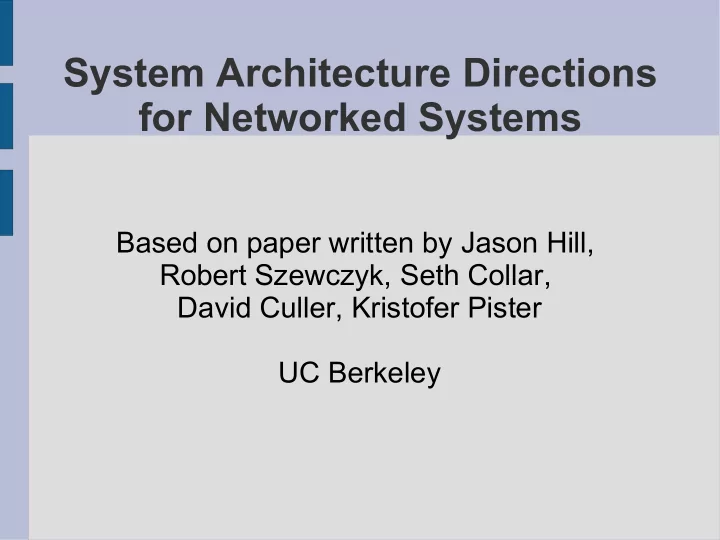

System Architecture Directions for Networked Systems Based on paper written by Jason Hill, Robert Szewczyk, Seth Collar, David Culler, Kristofer Pister UC Berkeley
Outline Introduction Networked sensor characteristics Example design point TinyOS design Evaluation, related work & implications
Introduction ● Trends in sensor design ● Smaller, cheaper & fully functional ● Smart dust – integrated into physical environment ● System software to manage and operate the device is missing ● Authors have developped TinyOS to address this problem
Sensor characteristics ● Small physical size and low power consumption ● Size and power constrain the processing, storage and interconnect capability of the device ● Software must make efficent use of processor and memory while enabling low power consumption
Sensor characteristics ● Concurrency-intensive operations ● The primary mode of operation is to flow information from place to place with a modest amount of processing on-the-fly ● Information may be captured from sensors, manipulated and streamed onto the network ● Data may by received and forwarded in a multi-hop routing
Sensor characteristics ● Limited physical parallelism and controller hierarchy ● Number of independent controllers, their capabilities are much lower than in conventional systems ● Sensor provides a primitive interface to a single-chip microcontroller
Sensor characteristics ● Diversity in design and usage ● Networked sensors are application specific and carry only the hardware support which is actually needed ● It is important to easily assemble the required software components – unusual level of modularity ● Applications should be constructed from components without heavyweight interfaces
Sensor characteristics ● Robust operations ● Devices are numerous and largely unattended – should be operational large percentage of time ● Redundancy vs Efficiency ● Enhancing the reliability of individual devices is essential
Example design point ● Microcontroller ● Internal flash program memory ● Data SRAM ● Sensors including LEDs, radio transceiver, photo and temperature sensors
Example design point
Example design point ● MCU is an 8-bit architecture (32 registers, 4 MHz) ● 8 KB program memory ● 512 bytes of SRAM data memory ● Using the coprocessor ● Three sleep modes ● Idle – shuts off the processor ● Power down – shuts everything ● Power save – async timer is still running
Example design point - sensors ● LEDs represent output through general I/O ● Photo sensor – analog input device ● Radio – async input/output device with hard realtime constraints ● Temperature sensor – analog sensor through I2C ● Serial port ● etc
Power characteristics
TinyOS design ● Two-level scheduling ● Hardware events can be performed immediately while long running tasks are interrupted ● System based on the event model ● Small amount of space needed ● Effective usage of CPU resources ● System consists of a tiny scheduler and a graph of components
TinyOS design - component ● Command handlers ● Event handlers ● Encapsulated fixed-size frame ● Bundle of tasks
TinyOS design - frame ● Fixed size frames are statistically allocated ● Prevents overhead associated with dynamic allocation ● Execution time savings regarding accessing the variables
TinyOS design - commands ● Non-blocking requests made to lower level components ● Will deposit request parameters into the frame and post a task for later execution ● May invoke lower level commands but must not wait for long actions to finish ● Must provide feedback by returning status
TinyOS design - events ● Are invoked to deal with hardware directly or not ● Can deposit information into the frame, post tasks, signal higher level events or call lower level commands ● Commands and events are intended to perform a small amount of work
TinyOS design - tasks ● Perform primary work ● Atomic with respect to other tasks (single allocated stack is needed), though can be preempted by events ● Can call lower level commands, signal higher level events or schedule other tasks ● Must never block or spin wait – this would prevent progress in other components
TinyOS design - scheduler ● Simple FIFO scheduler ● Power aware ● Whenever the task queue is empty it puts the processor to sleep ● Another task can be scheduled only as a result of hardware event
Example component
Component types ● Hardware abstraction components ● RFM radio ● Synthetic hardware components ● Radio byte ● High-level software components ● Messaging module
Putting it all together
Putting it all together ● How to determine topology? ● Base station periodically broadcasts out the route updates ● Each sensor within range rebroadcasts it and remembers the first update in the era ● When routing, the address of this sensor is used as a next hop
Putting it all together ● There are three events each device must respond to ● The arrival of the route update ● The arrival of the message that needs to be forwarded ● Collection of the new data (which is to be forwarded into the net)
Evaluation – code & data size
Evaluation – operations overhead
Data flow
Related work ● Current real-time embedded operating systems are not suitable for sensor systems ● Execution model similar to desktop systems (only smaller) ● Memory footprint is too big ● It takes to long to switch between contexts
Architecture implications ● Individual microcontroller for each sensor is not a requirement anymore ● For higher speed radio components bit level processing cannot be used – RadioByte will become hardware abstraction ● Hardware support for events (like more registers) would make the CPU load smaller and would lead to higher performance or lower power comsumption
Recommend
More recommend